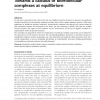Free Online Productivity Tools
i2Speak
i2Symbol
i2OCR
iTex2Img
iWeb2Print
iWeb2Shot
i2Type
iPdf2Split
iPdf2Merge
i2Bopomofo
i2Arabic
i2Style
i2Image
i2PDF
iLatex2Rtf
Sci2ools
BIB
2007
2007
Towards a calculus of biomolecular complexes at equilibrium
An overview is presented of the construction and use of algebraic partition functions to represent the equilibrium statistical mechanics of multimolecular complexes and their action within a larger regulatory network. Unlike many applications of equilibrium statistical mechanics, multimolecular complexes may operate with various subsets of their components present and connected to the others, the rest remaining in solution. Thus they are variablestructure systems. This aspect of their behavior may be accounted for by the use of ‘fugacity’ variables as a representation within the partition functions. Four principles are proposed by which the combinatorics of molecular complex construction can be reflected in the construction of their partition functions. The corresponding algebraic operations on partition functions are multiplication, addition, function composition and a less commonly used operation called contraction. Each has a natural interpretation in terms of probability distr...
| Added | 08 Dec 2010 |
| Updated | 08 Dec 2010 |
| Type | Journal |
| Year | 2007 |
| Where | BIB |
| Authors | Eric Mjolsness |
Comments (0)

